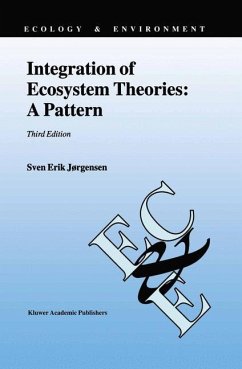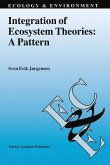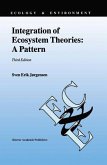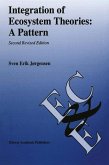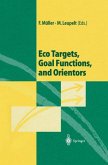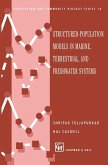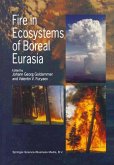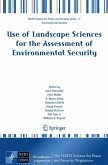Sven E. Jørgensen
Integration of Ecosystem Theories: A Pattern
Sven E. Jørgensen
Integration of Ecosystem Theories: A Pattern
- Broschiertes Buch
- Merkliste
- Auf die Merkliste
- Bewerten Bewerten
- Teilen
- Produkt teilen
- Produkterinnerung
- Produkterinnerung
- Weitere 7 Ausgaben:
- Gebundenes Buch
- Gebundenes Buch
- Broschiertes Buch
- Broschiertes Buch
- eBook, PDF
- eBook, PDF
- eBook, PDF
The book presents an integration of existing ecosystem theories in such a comprehensive way as to enable a full ecological and theoretical pattern to be presented. It shows that ecosystems and their reactions may be understood, provided that all basic systems ecology is applied to different aspects of the properties of ecosystems. Since the publication of the previous two editions of this book, ongoing research and discussions on an international scale have greatly clarified and enhanced this pattern. This progress is presented as Chapter 16 in this new, third edition. It is shown that the…mehr
Andere Kunden interessierten sich auch für
![Integration of Ecosystem Theories: A Pattern Integration of Ecosystem Theories: A Pattern]() Sven E. JørgensenIntegration of Ecosystem Theories: A Pattern41,99 €
Sven E. JørgensenIntegration of Ecosystem Theories: A Pattern41,99 €![Integration of Ecosystem Theories: A Pattern Integration of Ecosystem Theories: A Pattern]() Sven E. JørgensenIntegration of Ecosystem Theories: A Pattern161,99 €
Sven E. JørgensenIntegration of Ecosystem Theories: A Pattern161,99 €![Integration of Ecosystem Theories: A Pattern Integration of Ecosystem Theories: A Pattern]() Sven E. JørgensenIntegration of Ecosystem Theories: A Pattern77,99 €
Sven E. JørgensenIntegration of Ecosystem Theories: A Pattern77,99 €![Eco Targets, Goal Functions, and Orientors Eco Targets, Goal Functions, and Orientors]() MüllerEco Targets, Goal Functions, and Orientors121,99 €
MüllerEco Targets, Goal Functions, and Orientors121,99 €![Structured-Population Models in Marine, Terrestrial, and Freshwater Systems Structured-Population Models in Marine, Terrestrial, and Freshwater Systems]() Shripad Tuljapurkar / Hal Caswell (eds.)Structured-Population Models in Marine, Terrestrial, and Freshwater Systems122,99 €
Shripad Tuljapurkar / Hal Caswell (eds.)Structured-Population Models in Marine, Terrestrial, and Freshwater Systems122,99 €![Fire in Ecosystems of Boreal Eurasia Fire in Ecosystems of Boreal Eurasia]() GoldammerFire in Ecosystems of Boreal Eurasia161,99 €
GoldammerFire in Ecosystems of Boreal Eurasia161,99 €![Use of Landscape Sciences for the Assessment of Environmental Security Use of Landscape Sciences for the Assessment of Environmental Security]() Irene Petrosillo / Felix Müller / K. Bruce Jones / Giovanni Zurlini / Kinga Krauze / Sergey Victorov / Bai-Lian Li / William G. Kepner (eds.)Use of Landscape Sciences for the Assessment of Environmental Security154,99 €
Irene Petrosillo / Felix Müller / K. Bruce Jones / Giovanni Zurlini / Kinga Krauze / Sergey Victorov / Bai-Lian Li / William G. Kepner (eds.)Use of Landscape Sciences for the Assessment of Environmental Security154,99 €-
-
-
The book presents an integration of existing ecosystem theories in such a comprehensive way as to enable a full ecological and theoretical pattern to be presented. It shows that ecosystems and their reactions may be understood, provided that all basic systems ecology is applied to different aspects of the properties of ecosystems. Since the publication of the previous two editions of this book, ongoing research and discussions on an international scale have greatly clarified and enhanced this pattern. This progress is presented as Chapter 16 in this new, third edition. It is shown that the integrated ecosystem theory presented can be applied to explain various ecological observations and rules.
Audience: Researchers and decision makers whose work involves the study of ecosystems and ecology. This book is also recommended for use in graduate courses.
Hinweis: Dieser Artikel kann nur an eine deutsche Lieferadresse ausgeliefert werden.
Audience: Researchers and decision makers whose work involves the study of ecosystems and ecology. This book is also recommended for use in graduate courses.
Hinweis: Dieser Artikel kann nur an eine deutsche Lieferadresse ausgeliefert werden.
Produktdetails
- Produktdetails
- Ecology & Environment Nr.3
- Verlag: Springer / Springer Netherlands
- Artikelnr. des Verlages: 978-1-4020-0755-2
- 3rd ed.
- Seitenzahl: 440
- Erscheinungstermin: 31. August 2002
- Englisch
- Abmessung: 234mm x 156mm x 24mm
- Gewicht: 612g
- ISBN-13: 9781402007552
- ISBN-10: 1402007558
- Artikelnr.: 21632705
- Herstellerkennzeichnung Die Herstellerinformationen sind derzeit nicht verfügbar.
- Ecology & Environment Nr.3
- Verlag: Springer / Springer Netherlands
- Artikelnr. des Verlages: 978-1-4020-0755-2
- 3rd ed.
- Seitenzahl: 440
- Erscheinungstermin: 31. August 2002
- Englisch
- Abmessung: 234mm x 156mm x 24mm
- Gewicht: 612g
- ISBN-13: 9781402007552
- ISBN-10: 1402007558
- Artikelnr.: 21632705
- Herstellerkennzeichnung Die Herstellerinformationen sind derzeit nicht verfügbar.
Prof. Sven Erik Jørgensen is one of the two distinguished ecologists to receive the 2004 Stockholm Water Prize for Outstanding Contributions for the World's Lakes and Wetlands, "for their pioneering development and global dissemination of ecological models of lakes and wetlands, widely applied as effective tools in sustainable water resource management". The full text of the release plus photos and background can be found at http: www.siwi.org or http://www.siwi.org/press/presrel_04_SWP_Winner_Eng.htm
1. Introduction: Recent Trends In Science.- 1.1 How Did It start.- 1.2 Physics versus Ecology.- 1.3 Ecology and Physics.- 1.4 Recent Trends in Science.- 1.5. The Ecosystem as an Object of Research.- 2. Do We Need A New, Holistic Ecology.- 2.1 Two Ecologies.- 2.2 Complexity of Ecosystems.- 2.3 Ecology and Quantum Theory.- 3. Models In Ecology.- 3.1 Modelling in Ecology.- 3.2 Modelling Elements.- 3.3 The Modelling Procedure.- 3.4 Types of Models.- 3.5 Complexity of Models.- 3.6 Modelling Constraints and Recent Developments in Ecological Modelling.- 3.7 Application of Models as Scientific, Experimental Tools.- 4. Energy And Ecology.- 4.1 Conservation of Energy and Matter.- 4.2 Energy Flows in Ecosystems.- 4.3 The Maximum Power Principle.- 4.4 Embodied Energy / Emergy.- 5. Entropy And Ecology.- 5.1 The Second Law of Thermodynamics Applied to Ecosystems.- 5.2 Information and Entropy.- 5.3 Ecosystems Generate Entropy.- 5.4 Ecosystems are Non-isolated Systems.- 5.5 Energy Sources and Sinks Establish Order.- 5.6 Self-organization.- 5.7 The Maximum Entropy and Maximum Energy Dissipation Theory.- 6. Exergy And Ecology.- 6.1 The Application of Exergy in Ecological Thermodynamics.- 6.2 Exergy and Information.- 6.3 Application of the Third Law of Thermodynamics in Ecosystem Theory.- 6.4 Application of Exergy in Ecosystem Theory and Darwin's Theory.- 6.5 Computation of Exergy.- 6.6 Exergy and Modelling.- 6.7 The Tentative Fourth Law of Thermodynamics.- 7. Network And Hierarchical Concepts Of Ecosystems.- 7.1 Networks in Ecology.- 7.2 Networks Concepts.- 7.3 Hierarchical Theory of Ecosystems.- 7.4 Network Thermodynamics.- 8. Utility Theory, Indirect Effect And Ascendancy.- 8.1 Towards a wider Application of Network Theory.- 8.2 Energy Transfer and Utilization Coefficients inNetworks.- 8.3 The Indirect Effects in Networks.- 8.4 Ascendancy.- 9. Catastrophe Theory And Ecology.- 9.1 What is Applied Catastrophe Theory.- 9.2 Application of Catastrophe Theory to Explain Shifts in Oxygen Concentration as Function of Time in a Stream.- 9.3 Application of Catastrophe Theory on a Lake Ecosystem.- 9.4 General Application of Catastrophe Theory in Ecology.- 9.5 Ecosystems and Catastrophe Theory.- 10. Chaos, Fractals And Ecology.- 10.1 Introduction and Definitions.- 10.2 Bifurcation and Fractal Dimension.- 10.3 Ecological Implications.- 10.4 Parameter Estimations and Chaos.- 11. Ecosystem Health.- 11.1 Ecosystem Health and Integrity.- 11.2 Ecosystem Integrity and Environmental Changes.- 11.3 Exergy, Structural Exergy and Buffer Capacities as Ecological Indicators.- 11.4 A Practical Procedure to Assess (Partially) Ecosystem Health.- 11.5 Assessment of Ecosystem Health, An Example, A Lake Ecosystem.- 11.6 Agroecological Sustainability and Ecosystem Maturity.- 12. Development Of Ecosystems.- 12.1 Development and Evolution of Ecosystems.- 12.2 Development (Growth) of Ecosystems.- 12.3 Response of Growth to Seasonal Changes.- 12.4 Ecosystem Properties.- 13. Dynamic Of Ecosystems.- 13.1 Ecosystem Dynamic.- 13.2 Modelling Structural Dynamics.- 13.3 Constraints on Ecological Parameters.- 13.4 Application of Exergy as Goal Function in Ecological Modelling.- 13.5 Structurally Dynamic Models of Ecosystems.- 13.6 The Intermediate Disturbance Hypothesis (IDH) and Structural Dynamic Models.- 13.7 Structural Dynamic Models in Population Dynamics.- 13.8 Conclusions.- 14. Goal Functions, Ecological Indicators And Orientors.- 14.1 Introduction.- 14.2 Review of Goal Functions.- 14.3 Comparison of Goal Functions by Use of Models.- 14.4 Other comparisons of Goal Functions.-14.5 Cosmological Considerations.- 14.6 Exergy Storage / Exergy Destruction.- 14.7 Conclusions.- 15. A Tentative Pattern Of Ecosystem Theories.- 15.1 Presentation of a Pattern.- 15.2 A Central Law of Ecosystem Theories.- 15.3 Relations to Other Theories.- 15.4 Tools: Networks and Models.- 15.5 Propositions on Ecosystem Properties.- 15.6 The Application of ELT in Specific Cases.- 16. Towards A Consistent Ecosystem Theory.- 16.1 Introduction.- 16.2 A Reformulation.- 16.3 A Theoretical Network is needed in Ecology.- 16.4 Further Examples of Ecological Observations that can be derived from thermodynamic hypotheses.- 16.5 A consistent Pattern of Ecosystem Theories has been formed.- 16.6 A Model of the three Growth Forms.- 16.7 Closing Remarks.- 17 Epilogue.- 18. Appendix 1. Definitions Of Concepts.- 19. References.- 20. Index.
1. Introduction: Recent Trends In Science.- 1.1 How Did It start.- 1.2 Physics versus Ecology.- 1.3 Ecology and Physics.- 1.4 Recent Trends in Science.- 1.5. The Ecosystem as an Object of Research.- 2. Do We Need A New, Holistic Ecology.- 2.1 Two Ecologies.- 2.2 Complexity of Ecosystems.- 2.3 Ecology and Quantum Theory.- 3. Models In Ecology.- 3.1 Modelling in Ecology.- 3.2 Modelling Elements.- 3.3 The Modelling Procedure.- 3.4 Types of Models.- 3.5 Complexity of Models.- 3.6 Modelling Constraints and Recent Developments in Ecological Modelling.- 3.7 Application of Models as Scientific, Experimental Tools.- 4. Energy And Ecology.- 4.1 Conservation of Energy and Matter.- 4.2 Energy Flows in Ecosystems.- 4.3 The Maximum Power Principle.- 4.4 Embodied Energy / Emergy.- 5. Entropy And Ecology.- 5.1 The Second Law of Thermodynamics Applied to Ecosystems.- 5.2 Information and Entropy.- 5.3 Ecosystems Generate Entropy.- 5.4 Ecosystems are Non-isolated Systems.- 5.5 Energy Sources and Sinks Establish Order.- 5.6 Self-organization.- 5.7 The Maximum Entropy and Maximum Energy Dissipation Theory.- 6. Exergy And Ecology.- 6.1 The Application of Exergy in Ecological Thermodynamics.- 6.2 Exergy and Information.- 6.3 Application of the Third Law of Thermodynamics in Ecosystem Theory.- 6.4 Application of Exergy in Ecosystem Theory and Darwin's Theory.- 6.5 Computation of Exergy.- 6.6 Exergy and Modelling.- 6.7 The Tentative Fourth Law of Thermodynamics.- 7. Network And Hierarchical Concepts Of Ecosystems.- 7.1 Networks in Ecology.- 7.2 Networks Concepts.- 7.3 Hierarchical Theory of Ecosystems.- 7.4 Network Thermodynamics.- 8. Utility Theory, Indirect Effect And Ascendancy.- 8.1 Towards a wider Application of Network Theory.- 8.2 Energy Transfer and Utilization Coefficients inNetworks.- 8.3 The Indirect Effects in Networks.- 8.4 Ascendancy.- 9. Catastrophe Theory And Ecology.- 9.1 What is Applied Catastrophe Theory.- 9.2 Application of Catastrophe Theory to Explain Shifts in Oxygen Concentration as Function of Time in a Stream.- 9.3 Application of Catastrophe Theory on a Lake Ecosystem.- 9.4 General Application of Catastrophe Theory in Ecology.- 9.5 Ecosystems and Catastrophe Theory.- 10. Chaos, Fractals And Ecology.- 10.1 Introduction and Definitions.- 10.2 Bifurcation and Fractal Dimension.- 10.3 Ecological Implications.- 10.4 Parameter Estimations and Chaos.- 11. Ecosystem Health.- 11.1 Ecosystem Health and Integrity.- 11.2 Ecosystem Integrity and Environmental Changes.- 11.3 Exergy, Structural Exergy and Buffer Capacities as Ecological Indicators.- 11.4 A Practical Procedure to Assess (Partially) Ecosystem Health.- 11.5 Assessment of Ecosystem Health, An Example, A Lake Ecosystem.- 11.6 Agroecological Sustainability and Ecosystem Maturity.- 12. Development Of Ecosystems.- 12.1 Development and Evolution of Ecosystems.- 12.2 Development (Growth) of Ecosystems.- 12.3 Response of Growth to Seasonal Changes.- 12.4 Ecosystem Properties.- 13. Dynamic Of Ecosystems.- 13.1 Ecosystem Dynamic.- 13.2 Modelling Structural Dynamics.- 13.3 Constraints on Ecological Parameters.- 13.4 Application of Exergy as Goal Function in Ecological Modelling.- 13.5 Structurally Dynamic Models of Ecosystems.- 13.6 The Intermediate Disturbance Hypothesis (IDH) and Structural Dynamic Models.- 13.7 Structural Dynamic Models in Population Dynamics.- 13.8 Conclusions.- 14. Goal Functions, Ecological Indicators And Orientors.- 14.1 Introduction.- 14.2 Review of Goal Functions.- 14.3 Comparison of Goal Functions by Use of Models.- 14.4 Other comparisons of Goal Functions.-14.5 Cosmological Considerations.- 14.6 Exergy Storage / Exergy Destruction.- 14.7 Conclusions.- 15. A Tentative Pattern Of Ecosystem Theories.- 15.1 Presentation of a Pattern.- 15.2 A Central Law of Ecosystem Theories.- 15.3 Relations to Other Theories.- 15.4 Tools: Networks and Models.- 15.5 Propositions on Ecosystem Properties.- 15.6 The Application of ELT in Specific Cases.- 16. Towards A Consistent Ecosystem Theory.- 16.1 Introduction.- 16.2 A Reformulation.- 16.3 A Theoretical Network is needed in Ecology.- 16.4 Further Examples of Ecological Observations that can be derived from thermodynamic hypotheses.- 16.5 A consistent Pattern of Ecosystem Theories has been formed.- 16.6 A Model of the three Growth Forms.- 16.7 Closing Remarks.- 17 Epilogue.- 18. Appendix 1. Definitions Of Concepts.- 19. References.- 20. Index.

